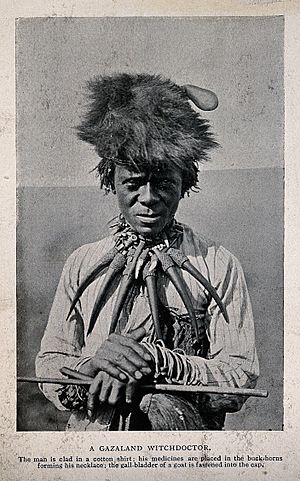Gazaland facts for kids
Gazaland is an old name for a part of southeast Africa. It's mostly in modern-day Mozambique and Zimbabwe. This area stretches from the Komati River near Delagoa Bay in southern Mozambique. It goes north all the way to the Pungwe River in central Mozambique.
Contents
History of Gazaland
Gazaland was once a region within Portuguese East Africa. This was the name for what is now Mozambique. The name "Gazaland" comes from a Swazi chief named Gaza. He lived around the same time as the famous Zulu king, Shaka.
The area of Gazaland covered much of what is now Gaza and Inhambane provinces. It also included parts of Manica and Sofala provinces.
The Rise of Soshangane
Many people were forced to leave their homes by Dingane. He was Shaka's successor. These refugees were brought together by Gaza's son, Soshangane. His followers became known as the Shangaan or Mashangane. Some of them were also called Maviti or Landeens.
Between 1833 and 1836, Soshangane took control of a large area. This stretched north to the Zambezi River. He captured Portuguese trading posts like Delagoa Bay, Inhambane, Sofala, and Sena. Most people living there were killed. The Portuguese tried to get their posts back. But they had a very hard time holding onto them. Soshangane continued to conquer more land. He caused many areas to become empty of people.
Umzila's Rule
Soshangane died around 1856. His son, Umzila, then became chief. The Portuguese at Delagoa Bay helped Umzila in a fight against his brother. In return, Umzila gave them the land south of the Komati River.
North of that river, Umzila became an independent ruler. He controlled the land up to the Zambezi River and inland to the plateau. He kept this independence until he died around 1884.
Gouveia's Influence
Umzila's main rival was a man from Goa named Manuel António de Sousa. He was also known as Gouveia. He came to Africa around 1850. Gouveia gained control of a large estate in the Gorongosa District. He ruled this area like a powerful lord. He said he was a Portuguese subject, but he acted very independently.
Gouveia took much of the Zambezi valley from the Shangaan people. The Portuguese government then made him a captain-general. This meant he was in charge of a very large region.
Exploring Gazaland
The first European to travel far inland from the Sofala coast was likely St Vincent Whitshed Erskine. This happened in the late 1800s. He explored the area between the Limpopo and Pungwe rivers from 1868 to 1875.
By the time Umzila died, Portugal had stronger control over the coast. They tried to claim Umzila's successor, Gungunyana, as their subject. They also worked to open up the inland areas.
Border Conflicts
These efforts led to clashes in 1890-1891. The conflicts were on the border of the plateau. This was where the new British South Africa Company was setting up. Gouveia was even arrested by the company's agents. However, he was later freed and returned to Mozambique.
The border between the British and Portuguese colonies was officially set. This happened with the Anglo-Portuguese Treaty on June 11, 1891. In 1891, Gungunyana offered to come under British protection. But this offer was not accepted.
In 1892, Gouveia was killed in a war with a local chief. Gungunyana remained independent until 1895. That year, he was captured by Portuguese forces. He was sent away, first to Lisbon and then to the Azores islands. He died there in 1906. After Gungunyana was captured, most resistance to Portuguese rule ended.
Gold Mining in Gazaland
In the early 1900s, Gazaland became an important place. It was one of the main areas for recruiting workers. These workers went to the South African gold mines.


